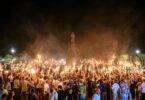Andrey Kolesnikov
The “correct” memory of the war is contrasted with the “wrong” and seemingly politically motivated me-mory of the repressions. There is a juxtaposition of two discourses that divide the nation, although they should have united.
The French journalist Pierre Veilletet’s description of the farewell to Francisco Franco almost literally reproduces the farewell ceremony with Stalin – of course, adjusted for the ideological and national-historical background. An endless stream of people, whose faces reflect all possible emotions – from furious grief to fairground curiosity: “Here is a married couple, they are quite simple, poorly dressed people, they are crying, holding on to each other. Behind them is a bourgeois lady, she just got from the hairdresser. She takes a rose out of her crocodile skin purse … Here a Capuchin monk crossed the coffin and furtively pulls out a camera from under his cassock … Here is a gentleman in the uniform of the Blue Division, he is holding himself right thanks to the armor from awards. ” “The roots of Francoism are a hundred times more popular, deep and ramified than we imagined,”
The reburial of the caudillo’s remains in October 2019, 44 years after his death, provoked a temporary exacerbation of the war of memory in Spain, more precisely, of memories. It will soon be 60 years since Stalin was carried out of the mausoleum, but it seems that his funeral is still going on in the heads of the post-Soviet people.
The pantheon of Soviet gods has become dilapidated, but new heroes have not come to replace this paradigm – and even pre-perestroika – of ideas about who is an outstanding historical personality. Is that Putin, and even he in recent years has lost half of his historical greatness: back in 2017, 32% of respondents considered him the most outstanding person in history , then he caught up with Pushkin and was second only to Stalin, and now with 15% he is included only in top-5, yielding to Peter I and two points bypassing Yuri Gagarin. Stalin, Lenin, Pushkin – this trio, stable in their paradoxicality, constitutes the pantheon of the old new gods of the mass Russian consciousness. Stalin stands as a monument to himself in the first place. For years.
Great and respected leader
In May 2021, 56% of the Levada Center respondents to one degree or another ag-reed with the point of view that Stalin was an “outstanding leader” (“totally agree” – 31%). In 2016, when the Stalinization of the mass consciousness had been an obvious trend for several years, half of the respondents considered the Generalissimo the “great leader” – 28%.
Putin followed in Stalin’s footsteps – also in the sense that he became the modern embodiment of the idea of ??establishing order. But there was no order, and there is still no order. In real politics, there is no substitute for Putin and cannot be. In imaginary politics, there is such a substitute – Stalin. More precisely, the myth about him, where both dissatisfaction with the current state of affairs and simplified ideas about the country’s past, which Putin’s establishment imposed on the nation, were united.
Elites privatize Victory, while legislatively prohibiting comparing Stalin to Hitler, but this mechanic stops working for Putin: he acts not as a follower of the Generalissimo, but as his not very successful, despite the annexation of Crimea, an epigone.
One can, of course, be surprised that Stalin’s popularity is consistently, and sometimes explosively, growing. But this is a completely natural consequence of the government-encouraged and sponsored policy of historical amnesia and the literal rewriting of history. Even those historical events that were not the subject of ideological and factual discussion suddenly begin to be disputed. And given the lack of transmission in the masses of historical knowledge, they immediately form a new mythology.
A few years ago, challenging the well-known facts about the Katyn crime on the website of the state agency would have been absolutely impossible. Today, the boundaries of what is permissible – factually and ethically – of discourse are expanding, and the red lines intersect with impudent ease: disputes about who committed the Katyn crime are renewed with renewed vigor.
On the website of the same agency, a stay in the Gulag is assessed as a “ticket to life.” In Soviet times, a very specific historical discourse was supported, for the storage and distribution of Solzhenitsyn’s “GULAG Archipelago” one could go to jail, but in the official media environment no one allowed himself such assessments of the Stalinist machine for the destruction of millions of people – invisible, but clear to everyone, ethical boundaries are all were present.
From the words of the authorities of different levels, they are moving on to deeds: in the spring of 2020, memorial plaques from the former building of the local NKVD were dismantled in Tver , where in April – May 1940, 6,311 Poles were executed – prisoners of the Ostashkov camp. This is an act of official vandalism, because the plates were disposed of according to the decisions of the local prosecutor’s office and local authorities.
There will be no modernization without de-Stalinization
The results of the introduction of a simplified version of history into the mass consciousness are best seen in the example of how respondents interpret the main historical event for Russians – the Great Patriotic War. The legitimation of the current political regime and the unity of most of the nation are largely held in the memory of the Great War. The head of state himself actually rehabilitated the secret protocols of the Molotov-Ribbentrop Pact, and in the official interpretation this is already a “diplomatic triumph of the USSR.” What Soviet ideologists and historians were ashamed of, what Soviet leaders, including Mikhail Gorbachev, concealed and denied to the last , became a matter of overbearing pride.
And ideas about the events that preceded the war and its first days literally became Stalinized: just as the pantheon of historical heroes remained the same, pre-perestroika, so did the mythological interpretation of the beginning of World War II and the Great Patriotic War. The idea that the Red Army was “stunned” by the suddenness of the German attack, and that the USSR did not prepare for war, so as not to provoke Germany, became entrenched in the mass consciousness. Everything was well known about the att-ack. And the fear of provocations became Stalin’s par-anoia, which, however, did not at all prevent him from preparing for war, albeit in his own specific way.
And here are the biggest problems with this specificity. The fact that the leadership of the Red Army was drained of blood by the Stalinist purges, in 2005, was in agreement with 40% of the respondents of the Levada Center – this knowledge from the time of perestroika was still a commonplace. In 2021, there are only 17% of such respondents. 23 percentage points over 16 years is a staggering degradation of historical knowledge.
The memory of the repressions did not become the glue of the nation, like the memory of the war. Moreover, it has not entered the culture of national ideas about history. For many, this is not just an optional part of the country’s history, but also an ideologically marked period: after all, those who keep the memory of the repressions are foreign agents (the Memorial society). Only 16% have a negative attitude towards the Last Address project, which perpetuates the memory of the repressed with tablets (14% find it difficult to define their attitude), but the motivation of these people is symptomatic : “repressed for the cause” is the prevailing point of view; “Houses will look like cemeteries”, “why is this necessary?”, “Such memory is not needed”.
As a result, the “correct” memory of the war is opposed to the “wrong” and seemingly politically motivated memory of the repressions: the frequent acts of vandalism against the “Last Address” plates are proof of this. In June, in Yekaterinburg, unknown persons even pasted over the memorial signs with the symbols of Victory Day – this is a more than intelligible opposition of two discourses that divide the nation, although they should have united.
In the meantime, Russians are united by Stalin, a great leader for 56%, to whom respondents regard with increasing respect: 21% in 2012, before Crimea; 45% in 2021 – after the pension reform and the pandemic.
Stalin replaces the absent modern heroes, covers with his shadow the entire significant history of the 20th century, symbolically compensates for the failures, defeats and failures of recent years. In fact, Stalin has not yet been buried. The endless funeral going on in the historical circle continues. The modernization of Russia will once again have to start with de-Stalinization.






